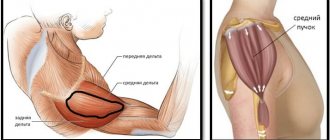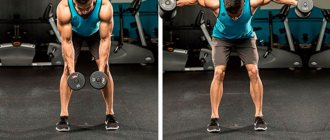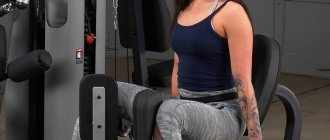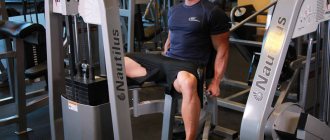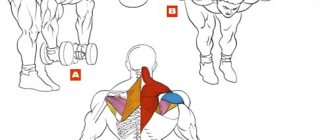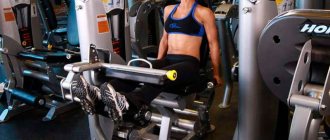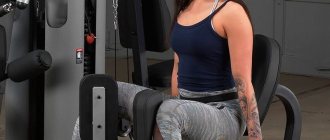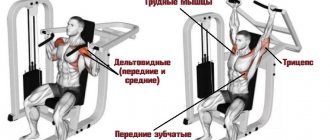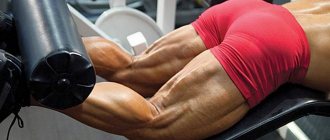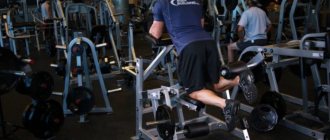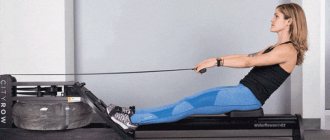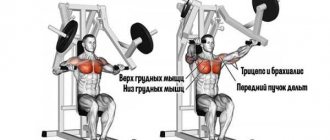The reverse fly exercise in the peck-deck machine pumps up the rear deltoids, trapezius and rotator cuff muscles. Adds detail to the shoulders and upper back. Isolation exercise.
Reverse flyes are a tool for fine-tuning the shape and relief of the rear deltoids, as well as all the muscles of the upper back. In addition, reverse flyes strengthen the rotator cuff muscles, the strength of which directly determines the resistance of the shoulder joint to stress.
By regularly practicing reverse flyes, you will improve your athletic performance in rowing, archery, gymnastics, tennis, baseball and wrestling.
Reverse flyes in the butterfly simulator - exercise for shoulders (deltas)
Benefits and disadvantages of exercise
The main advantages of reverse peck-dec breeding:
- Isolating study of the lagging beam.
- Improved posture and turning your shoulders back.
- Prevention of hernias and diseases of the spine in the lumbar and cervical regions.
- Suitable even for beginners.
- Neuromuscular control is not necessary to obtain benefits as with other posterior band exercises.
The disadvantages are conditional. Basically they come down to the wrong technique for performing a reverse butterfly.
Contraindications
The Butterfly simulator is available to people of any gender and age. It helps develop muscle tissue and keep it toned. The simulator is suitable for athletes, boxers, gymnasts and tennis players, since in these sports, the upper body must be strong and well developed.
There are special indications for such a simulator that need to be taken into account. The first applies to those who have problems with the cardiovascular system. Classes are prohibited, since during training on this simulator there is a load on the entire cardiovascular system, which can damage the process of the heart.
It is also prohibited for people with chronic diseases to exercise, especially when there is an exacerbation. The best thing to do before training is to be examined by a doctor and consult about the training process.
It is worth noting that even for healthy people, consulting a doctor will not be superfluous; he will help set up the training process and select the necessary set of exercises.
What muscles work
During movement, three large muscles are used:
- Deltoid (posterior head).
- Trapezoidal.
- Diamond-shaped.
are also included , but are not covered as they do not require focused training.
What is a "butterfly"
The Butterfly trainer is a design designed for mixing. It consists of a backrest, a chair and handles, which are attached to the load using a frame. During mixing, weights increase the load on the working area. It can be varied in weight. “Butterfly” got its name due to its appearance: frames with handles diverge to the side like wings. Some models have elbow rests, which makes work even more isolated.
Types of grip
To raise your arms in the simulator, three types of grip are used:
- Straight (classic) – palms facing each other. The most common grip, which is considered the most comfortable.
- Reverse - thumbs pointing to the floor, hands facing each other with their backs.
- Neutral – used in simulators where it is possible to use horizontal handles. Palms point down.
When working in peck-deck on the rear delt, choose the most comfortable grip. The best option is straight, as it is the most convenient and natural. Otherwise, changing the position of the hand does not in any way affect the load received by the posterior deltoids. Therefore, the benefits of using a reverse and neutral grip remain unproven.
#2 Flying dumbbells on a bench or fitball
In this exercise, as in the butterfly curl, you will be able to stretch your pecs at the lowest point . True, in the upper part, the load from the pectoral muscles will move to other muscle groups and will no longer be concentrated in the pectoral ones, as in the exercise with a fitball or in the same “butterfly”.
What is good about stretching at the bottom? Because stretching a muscle under load provides a stimulus for muscle growth. In one of the experiments we wrote about, this is confirmed. In it, a group of athletes who performed several sets of “stretching” using weights received an increase in muscle thickness compared to the control group.
The exercise can be performed at home on a horizontal bench or in a fitball . In the case of a fitball, it will be a little more difficult, since you will need to tense your core muscles to hold your body. Good too !
The exercise is more traumatic for the shoulder joint than the alternative with a fitball. So if you have problems with it, it’s better to forget about wiring.
Execution technique
The movements must be performed slowly and under control. The weight of the weights plays a less important role than correct execution.
Sitting technique:
- Adjust the seat height so that your arm moves back in a horizontal plane (moves parallel to the floor).
- Adjust the back of the exercise machine so that it fixes the position of the body.
- Sit in the machine and grab the handles.
- Begin to slowly spread your arms to the sides until your hands are at the same level (arm abduction 90 degrees).
- Take a short break and slowly return to the starting position.
- At the bottom point, do not bring the handles together to maintain tension in the muscles.
- The key feature is the position of the shoulders. Often, athletes raise their shoulders when raising their arms back, performing a movement similar to shrugs. This is a bug that takes some of the load off the target area.
- It should also be remembered that the rear beam will be activated in isolation only when working with light weights. Otherwise, the trapezius and other muscles will take the load, so it is recommended to do the movement in a multi-repetition mode.
Prices
If you try hard to find such a simulator, you can find it starting from 30 thousand rubles. The price for a European simulator can start from 50 thousand rubles.
This type of simulator is not the cheapest option, but in operation, it is completely justified. It doesn’t matter whether you are building a home gym or opening your own fitness club, this machine will be indispensable. After all, there are no similar exercises that will work the chest like this.
The price for such a simulator is influenced by several factors. This is the country of manufacture, equipment, quality, weight of the blocks, the load that it can withstand.
It’s worth noting right away that domestically produced simulators will be much cheaper, but their development focuses on practicality, and appearance is left in the background. For a modern fitness room, such a machine may turn out to be a “black sheep”, although it will not be inferior in functionality to its foreign colleagues. But European manufacturers focus on quality and appearance; such exercise machines will immediately fit into the interior of any gym.
The weight of the blocks will also affect the total cost of the simulator; the greater the weight of the weight, the more material is spent, and accordingly the higher the price.
Recommendations
- The movement should not be done at the beginning of a workout. It is optimal to perform it in the middle of the session, after a heavy “base”, when the muscles are already warmed up. This will help to better load the target muscle.
- It is optimal to do 10-15 repetitions per set. The last 2-3 approaches should be performed with difficulty and precede muscle failure.
- It is enough to work the muscle in peck-dec once a week, 3-4 repetitions.
- If you are performing a super series exercise, always start with the movement that loads the lagging head.
Preparing for the exercise
This movement completes the set of exercises for the chest muscles. It is understood that joint exercises and pre-stretching are done before the first bench press. Beginners should perform no more than 12 working approaches of all exercises per workout; experienced athletes can do more by individually selecting the load.
Stretching muscles in the middle of a workout before one exercise makes no sense. Typically, such actions reduce the strength of muscle contractions and reduce the effectiveness of the exercise.
The exception is stretching the triceps after the main pressing movements. You need to sit on a bench, place your forearm behind your head and lightly press on your elbow. This will help you bring your arms in front of you more comfortably, but will not remove the tone from your chest.
How to replace the exercise
If the gym does not have butterfly or peck-deck machines, you can consider the following as a replacement:
- Bent-over rear delt fly.
- Abduction of the arm upward while lying on the bench sideways.
Reviews
It is worth asking every person who works out in the gym, is the exercise machine, the butterfly, important? He will answer you without hesitation that this simulator is not replaceable.
One of the best bodybuilding trainers, Alexander Vishnevsky, always uses a machine to train athletes. He once stated this in an interview “... the best part for an athlete is the back and chest, so the chest is best trained with a barbell and a butterfly machine...”
One of the popular fitness bloggers, Denis Borisov, speaks very positively about the simulator. He says “that the exercise greatly emphasizes the work on the chest muscles, which is good for preparation, you should definitely include this movement in your training plan.” He also made a series of videos on how to perform exercises on this machine.
Anatomy of deltas
The deltoid muscle is not a single mass, but a group consisting of three bundles:
- anterior (clavicular part);
- middle (acromial part);
- posterior (spinous part).
© Alila Medical Media — stock.adobe.com
The frontal zone is involved in most exercises - it is the easiest to pump up. The side beams are responsible for the width of the shoulders - they need to be given special attention. The dorsal region is noticeable when viewed from the side - ignoring it, you will not get ideal spherical deltas.
Training program
Let's look at how to pump up your deltoids at home and in the gym.
Home workout program
Designed for one separate workout per week and work with dumbbells:
| Exercise with dumbbells | Approaches | Repetitions |
| Seated dumbbell press | 4 | 10-12 |
| Swing in front of you | 3 | 12-15 |
| Dumbbell row to the chin | 4 | 12-15 |
| Lateral spreads | 3 | 12-15 |
| Bent-over lateral raises | 5 | 12-15 |
What kind of exercise
Bringing your arms together in a “butterfly” or otherwise “peck-deck” is an isolated exercise for the pectoral muscles. They are the ones who do the work of bringing the arms to each other, contracting their fibers. The remaining muscles are practically not involved in the movement. It occurs in the shoulder joints according to the type of rotation - remember that this is a ball-and-socket joint, the head of the shoulder rotates in the glenoid cavity. The elbows and other joints of the upper limb bones remain fixed. The same applies to the body.
It is believed that mixing in the “butterfly” refers to additional exercises. It is mainly used for “clogging” muscles at the end, as well as for pumping. But for beginners, this is an excellent start in chest work.
Benefits for women's health
Yoga asanas, which strengthen the muscles of the legs, back and pelvis, are very beneficial for women's health. Yoga will help stretch muscles, helping them become stronger, more elastic, and relieve tension. A set of exercises designed for the leg muscles helps relieve pain during PMS.
Thus, the “butterfly” exercise helps not only make the leg muscles more elastic, but also helps improve blood supply to the pelvic organs. Regularly performing this exercise in combination with other yoga asanas makes the female body healthier, and the girl herself more attractive and desirable in the eyes of men.
The butterfly exercise for the legs is of enormous importance. Since during its execution the leg muscles are not only stretched, but also trained, which makes the entire hip area more toned.
In addition, the back muscles are trained. Correct posture is formed by alternating the load with stretching the muscles of the entire spine, at a time when the back is extended and the head is lowered down.
Common mistakes
The following mistakes often happen when mixing:
- arms are too straight - fully extended at the elbow joints;
- head down;
- rounding in the back, deflections;
- jerking movements;
- assistance with feet by inertia;
- lifting the feet off the floor;
- separation of the shoulder blades from the back;
- placing your hands behind the midline;
- too much weight;
- working too hard;
- the simulator is not adjusted to individual parameters (most often it is not adjusted according to height);
- gripping the handles very tightly, with a lot of tension in the hands;
- no coordination with breathing.
Another “mistake” can be considered high hopes for rapid muscle growth only on mixing. But this will not happen if you do not use other chest exercises.
Why Shoulders Are Often Injured?
In fact, dumbbell flyes are rarely a cause of injury unless the technique is truly horrendous. Some athletes may throw weights toward their heads, raise their arms too high, swing aggressively, and rotate their arms backward at the shoulders during the movement. They run a serious risk, but not of muscle tears, as is commonly believed, but of sprained ligaments and subsequent inflammatory processes.
The problem with shoulders is that they are loaded not only in sports, but also in everyday life. We sit a lot, raising our shoulders and overstraining our trapezius, we carry bags on one shoulder for a long time, stretching one half of our body and involuntarily shortening the other, and we often do sharp lifts of our arms without warming up. This leads to overload of the joints.
Let's say a person has never trained. He comes to the gym and starts doing bench presses, bench presses, sitting, standing, and a couple more presses, but this time with dumbbells. All of them work the deltoids and involve the joint. It is enough to overwork and make an awkward movement and you can get a tear or sprain.
Anatomical features are also of great importance. If the trapezius is overdeveloped, the athlete will not be able to perform the movement using the shoulders alone. This must be taken into account when choosing weights and start literally with 2-3 kg.
Injuries are often accompanied by inflammation, which is not localized, but spreads throughout the muscle bundle. They often affect the nerves, which increases the pain. Shoulder injuries should be diagnosed by a doctor. Home treatment based on guesswork will not lead to anything good.
There are two basic rules for creating a split for beginners:
- If you are performing a standing or seated press on shoulder training day, it does not need to be attached to your chest or back. Do shoulders with legs like the old school athletes and stay healthy;
- If there is no bench press in the workout, but only abductions and lifting, then perform shoulder training on the day of light bench press along with triceps work
Training shoulders with the back only makes sense if there is really nowhere else to put them, all the presses in the workout are heavy, the legs are also heavy, and the back is performed according to the “injury pumping” principle. But this is not typical in fitness. It's more of a powerlifter's approach.
Important: if a beginner is not yet doing splits, abductions can replace the bench press in some cases. For example, when during training the classic bench press with a barbell was taught, and the front deltoids were already overloaded
It's a STANDING DUMBELL SWING, baby.
Options
Depending on which deltoids you want to train, you need to stand either on the side of the machine, looking through it, or with your back to it, to perform rows in front of you, or in a bent position, facing the block. Accordingly, in the first case the middle beams will work, in the second – the front ones, in the third – the back ones. As the most common exercise, let’s take a closer look at training the middle deltoids.
Tips for performing asanas
The only thing worth remembering when performing any yoga asana is that all exercises should bring only pleasant sensations. If there is discomfort, then you are doing something wrong.
You need to perform all asanas in a calm state of mind, leave enough time for them so as not to rush anywhere and do everything calmly.
Yoga asanas help not only make the body more flexible, slender and resilient. Thanks to their regular implementation, in combination with correct breathing exercises, all organs and tissues are stimulated and renewed, starting to work correctly.
In addition, by doing exercises in the morning, you will be charged with energy and peace of mind for the whole day.
Partner news
June '17
- Pandemic
- Moscow
- Ekaterinburg
- Chelyabinsk
- Saint Petersburg
- Crimea
- Mound
- Tyumen
- Ugra
- Yamal
- Ural
- Siberia
- Far East
- Caucasus
- Russia
- In the world
- Europe
- Transnistria
- Ukraine
- central Asia
- Italy
- Balkans
- Scandals
- Policy
- Elections
- Interview
- Economy
- Finance
- Society
- Health
- Tourism
- Sport
- Culture
- The science
- Technologies
- Transport
- Photo report
- Video report
- Weekend 18+
- Author's column
- Pulp Fiction
- Propaganda
- Company news
- Revolution-1917
- Back to the 90s
- About the agency
- Advertising on the website
- Repubblica Italiana
- Voting on the site
- Stories of the New Day
- Investigations
- Search on the site
- Tag Cloud
